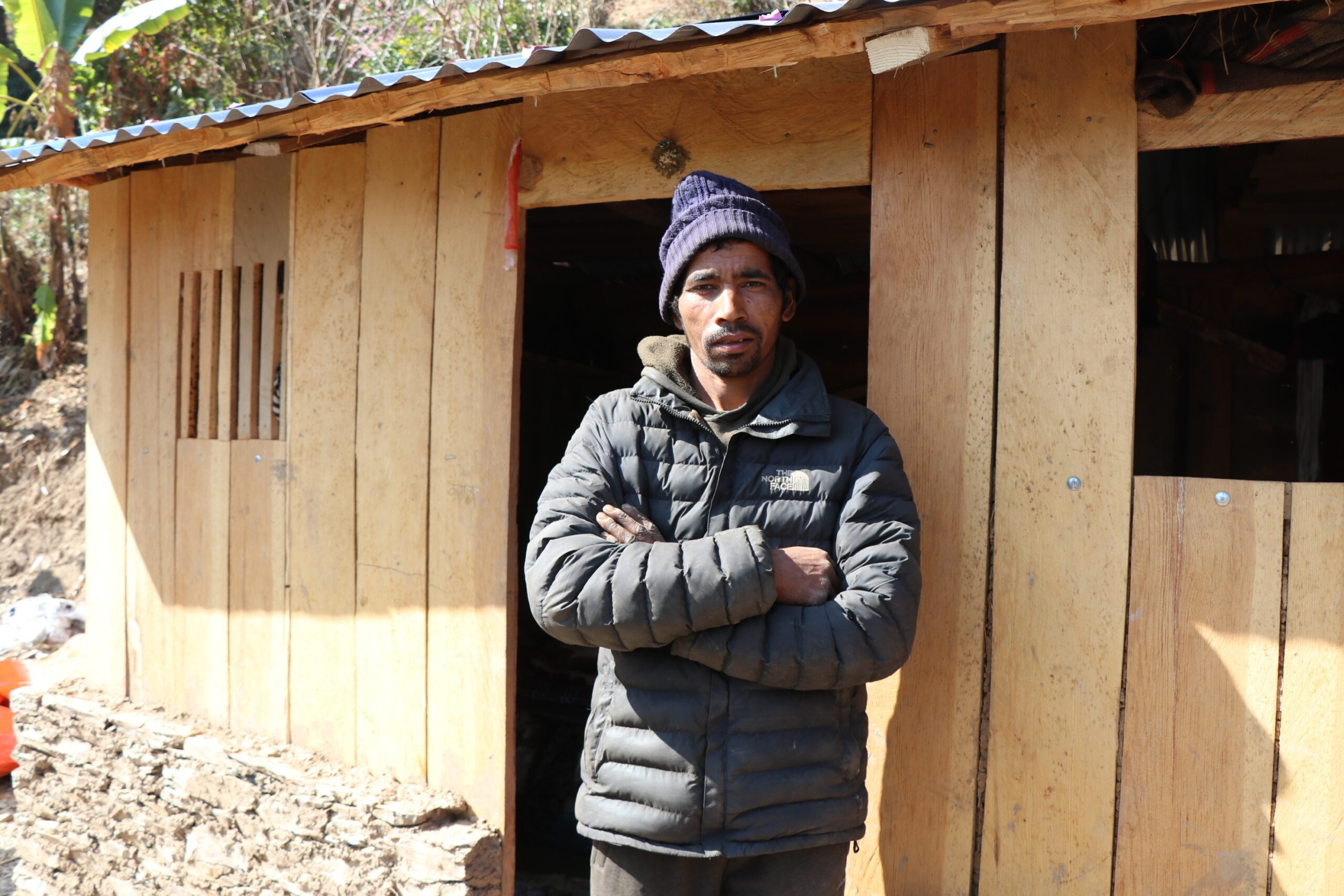Manbir uses skill to build a temporary shelter after earthquake
Since a powerful earthquake destroyed his home, Manbir has been building a transitional shelter for his family. Undeterred by his disability, he showed such skill in the construction of his shelter that other villagers were encouraged to observe and learn from his work.

Amid the rugged terrain and lush forests of his village in Nepal’s Jajarkot district, 43-year-old Manbir is facing the challenges of disability with unwavering courage, supported by his devoted family of 7, including his wife, 4 daughters, and 1 son.
“Despite being disabled since birth and unable to walk properly, I am the backbone of my household,” shares Manbir. “I toil as a farmer, tending to a small plot of land where we cultivate crops and vegetables to sustain our family.”
“Despite being disabled since birth and unable to walk properly, I am the backbone of my household.”
Manbir
In addition to farming, Manbir navigates the rugged landscape with his cattle, gathering fodder from the forest to supplement their diet. When called upon by his community, he lends a hand as a manual labourer, assisting in the construction of houses despite his lack of formal training. Although his disability often makes him a reluctant choice for employment, he perseveres, driven by a deep sense of responsibility to provide for his loved ones.
Tragedy strikes
One evening in November 2023, while Manbir’s wife and children were away attending a funeral in another village, he was alone at home when a powerful earthquake rocked their village. “My house shook dangerously, shattering all our belongings,” recalls Manbir. “I felt dizzy and nearly lost consciousness.”
“I felt dizzy and nearly lost consciousness.”
Manbir
As chaos engulfed the village, Manbir emerged from his home to find a scene of devastation. The once serene forest echoed with the cries of frightened animals and the rustle of swaying trees, while his own cattle bellowed in panic. With every step, pain shot through his legs, but he pressed on, driven by the need to seek safety with his neighbours.
Days stretched into weeks as Manbir and his family endured the harsh realities of displacement, finding temporary shelter beneath a makeshift tent constructed from bamboo and blankets. As their meager supplies dwindled, the ward office provided assistance in the form of a provision of rice and lentils to eat.
Building the transitional shelter
Manbir’s name was registered to receive aid and technical assistance to help him construct a temporary shelter for his family through a Plan International and SAC Nepal project in response to the earthquake.
Manbir embarked on the daunting task of building his temporary shelter, with guidance from the organisations, using locally available materials. Despite the challenges posed by his disability, he drew on his skills as a manual labourer to start work constructing a sturdy refuge for his family.
Individuals selected to take part in the project received a sum of NPR 75,000 deposited directly into their bank accounts. This payment covered their daily wages, expenses for constructing their temporary shelter and toilet, as well as all necessary materials required for the building process.
Bhusan Aryal is Plan International’s building specialist. “During my visit to Manbir’s village to oversee the construction of the temporary shelters, I was particularly impressed by Manbir’s attention to detail and adherence to instructions and protocols. We meticulously measured the dimensions of the shelter, ensuring it met the necessary standards.”
“What stood out was the addition of a false ceiling inside the shelter, a thoughtful touch that will provide insulation against both winter cold and summer heat. I am genuinely impressed by Manbir’s efforts, and I have instructed our partner organisation to encourage other villagers to observe and learn from his exemplary work.”
“What stood out was the addition of a false ceiling inside the shelter, a thoughtful touch that will provide insulation against both winter cold and summer heat.”
Bhusan Aryal, Construction Specialist, Plan International Nepal
Months passed, marked by tireless labour and unwavering resolve, until finally, Manbir’s temporary shelter was complete. A sense of relief washed over Manbir as he watched his children settle into their new home, shielded from the elements and the dangers of the wild.
“I prayed for no rain,” Manbir recalls. “Every nail driven and every beam placed brought us one step closer to safety.”



